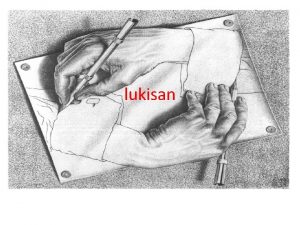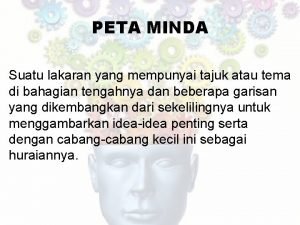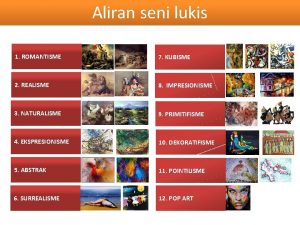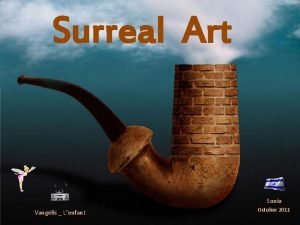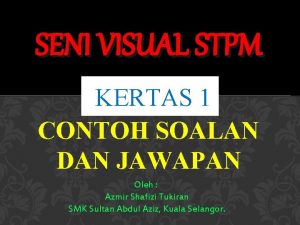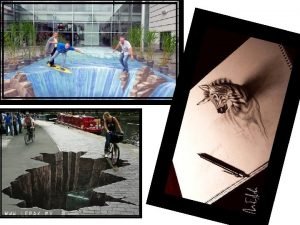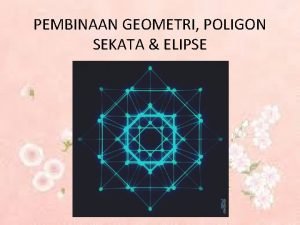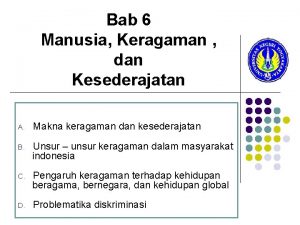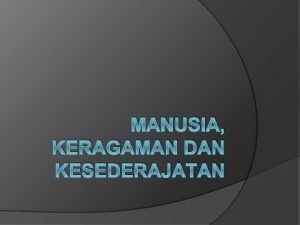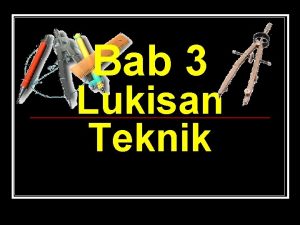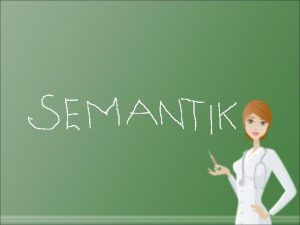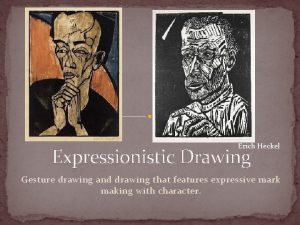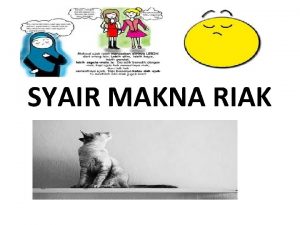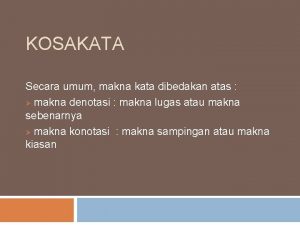DRAWING DEFINITIONS AND PURPOSES lukisan makna dan tujuan

























- Slides: 25

DRAWING – DEFINITIONS AND PURPOSES (lukisan – makna dan tujuan) noor azizi 2018

introduction Drawing serves a variety of purposes From historical data to cultural expression Art – especially the discipline of drawing helps us interpret our experiences visually, emotionally and aesthetically.

• Drawing can be political, polemical, didactic, dramatic, poetic, informative or conceptual.

Van Gogh Landscape of Wheat Field

Drawing? • Serves a variety of purposes – informal notation to accurate description, from social commentary to playful, inventive meandering, from psychological revelations to dramatic impact. • Mempunyai pelbagai tujuan – dari catatan bersahaja kepada penjelasan yang tepat, dari komentar social kepada jalinan berhibur dan penciptaan , dari luahan psaikologi kepada kesan yang dramatik. • Art – especially the discipline of drawing helps us interpret our experiences visually, emotionally and aesthetically. • Seni – terutama disiplin lukisan membantu kita didalam mentafsir pengalaman secara tampak, perasaan dan keindahan.

Zaha Hadid, quick sketch Zaha Hadid, soho showroom from informal notation to accurate description

Ahmad Fuad Osman, syhh? Dok diam-diam, jangan bantah From social commentary to inventive meandering

Picasso, Guernica, 1937 From psychological revealation to dramatic impact

• For the visual artist, drawing is the very core of interpreting our experiences. • Bagi seorang artis tampak, lukisan adalah tunjang bagi mentafsrikan pengalaman kita. • It offers a dialogue with ourselves and with others, the viewers. • Ia membuka satu dialog dengan diri sendiri juga dengan orang lain iaitu pemerhati. • A drawing can be autobiographical, political, polemic, didactic, playful, dramatic, poetic, informative or conceptual. • Lukisan boleh bersifat sebuah autobiografi, politik, polemik, pengajaran, menghiburkan, dramatik, puitis, bermaklumat atau konseptual.

Types of drawings- penjenisan lukisan • Subjective drawing – emphasised the artists emotions lukisan subjektif – menekankan perasaan pengkarya • Objective drawing – conveys information, not feeling lukisan objektif – menyampaikan maklumat, bukan perasaan

• Informational drawing – falls under the objective category – diagramatic and architectural drawing, plan drawing etc. Lukisan bermaklumat – dibawah kategori objektif – lukisan diagram, lukisan senibina, lukisan plan dll. • Schematic drawing – schematic or conceptual drawing – a mental construct rather than an exact transcription of visual reality. Lukisan skematik - lukisan skematik atau konseptual - pembinaan mental bukannya transkripsi sebenar realiti visual.

Subjective drawings

Objective drawing – convey information, not feeling

objective drawing

Informational drawing

informational

Schematic Dan slavinsky, iron orhid

schematic

Walt disney concert hall

Subject and Treatment • broad category of subjects include landscape, still life and figure drawing. • But how do artists treat these subjects? • There are innumerable modes of expression • From abstraction (Halaby) to real change to the landscape (Christo) to a narrative or allegory (Caivano)

• Samia Halaby, Olive Orchard in My Studio, 2000. Acrylic on paper. • Halaby treats landscape as an abstraction.

• Christo, over the river, : project for the Arkansas river, state of Colorado, 2001. Mix media. • Christo proposes changes to an existing landscape

• Ernesto Caivano, Losing It, 2004. Ink on paper. • Caivano suggests a narrative (penceritaan) or allegory (perlambangan). His work crosses the order between imagination and observation. It narrative is not in a linear sequence, up to the viewer to create a story line.

conclusion • The process of drawing develop a heightened awareness of the visual world, an awareness that is both subjective (knowing how to feel about things) and objective (understanding how things actually operate).

Terima kasih
 Jenis lukisan kejuruteraan
Jenis lukisan kejuruteraan Esai deskriptif adalah
Esai deskriptif adalah Contoh lukisan silang pangkah
Contoh lukisan silang pangkah Harmoni seni
Harmoni seni Soalan seni kertas 2
Soalan seni kertas 2 Peta minda jenis
Peta minda jenis Graf bar mudah geografi tingkatan 3
Graf bar mudah geografi tingkatan 3 Primitifisme
Primitifisme Olahan motif
Olahan motif Vangelis lenfant
Vangelis lenfant Teknik konvensional seni visual
Teknik konvensional seni visual Bentuk ilusi
Bentuk ilusi Tujuan dibentuknya persagi pada masa cita nasional adalah ?
Tujuan dibentuknya persagi pada masa cita nasional adalah ? Pepenjuru yang berserenjang
Pepenjuru yang berserenjang Isometric figure
Isometric figure Technical drawing presentation
Technical drawing presentation Apa makna sengsara dan wafat yesus bagi iman kita
Apa makna sengsara dan wafat yesus bagi iman kita Jelaskan faktor daya ikat konstitusi
Jelaskan faktor daya ikat konstitusi Makna kesederajatan
Makna kesederajatan Katekismus gereja katolik artikel 2333
Katekismus gereja katolik artikel 2333 Suatu kondisi dalam masyarakat dimana terdapat perbedaan
Suatu kondisi dalam masyarakat dimana terdapat perbedaan Jelaskan pengertian iman kepada qodlo dan qodar!
Jelaskan pengertian iman kepada qodlo dan qodar! Doa sebelum tahajud rumi
Doa sebelum tahajud rumi Makna sengsara dan wafat yesus
Makna sengsara dan wafat yesus Makna dasar adab dan peradaban
Makna dasar adab dan peradaban Makna sengsara dan wafat yesus
Makna sengsara dan wafat yesus


